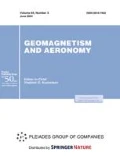Abstract
A model is proposed in which the electrical voltage measured between the electrodes in Lake Baikal is a consequence of two effects: electrochemical processes near the electrodes and a positive charge current flowing through the lake. The electrochemical component of the voltage in the case of lead electrodes arises due to the difference in concentrations of carbonate anion—\({\text{CO}}_{3}^{{2 - }}\) at different depths. In the case of the use of chlorine-silver electrodes, only the effect of the positive charge current flowing through the lake is measured. We proposed an interpretation of an increase of electrical voltage registered in Lake Baikal during an earthquake in August 2008. The reason for the increase in voltage is the release of positively charged hydrogen-containing gases from the Earth’s interior.

Similar content being viewed by others
REFERENCES
Bezrukov, L.B, Zavarzina, V.P., Kurlovich, A.S., Lubsandorzhiev, B.K., Mezhokh, A.K., Morgalyuk, V.P., and Sinev, V.V., On the negatively charged layer of the Earth’s electric field, Dokl. Phys., 2018, vol. 480, no. 2, pp. 177–179.
El-Egamy, S.S. and Badawy, W.A., Corrosion and passivation of Pb in \({\text{CO}}_{3}^{{2 - }}\) solutions, Indian J. Chem. Technol., 1996, vol. 3, pp. 37–43.
Korotaev, S.M., Shneer, V.S., Gaidash, S.P., Budnev, N.M., Mirgazov, R.R., Khalezov, A.A., and Panfilov, A.I., The effect and precursors of the earthquake of August 28, 2008, in the vertical component of the electric field in Lake Baikal, Dokl. Earth Sci., 2011, vol. 438, no. 2, pp. 842–845.
Korotaev, S.M., Budnev, N.M., Serdyuk, V.O., Zurbanov, V.A., Mirgazov, R.R., Shneer, V.S., Machinin, V.A., Kiktenko, E.O., Buzin, V.B., and Panfilov, A.I., Recent results of monitoring of the vertical component of the electrical field in Lake Baikal on the surface–bed baseline, Geomagn. Aeron. (Engl. Transl.), 2015, vol. 55, no. 3, pp. 398–409.
Mikhailov, V.A., Sorokina O.V., Savinkina, E.V., and Davydova, M.N., Khimicheskoe ravnovesie: uchebnoe posobie (Chemical Equilibrium: A Manual), Moscow: Binom, 2008.
Rusinek, O.T. Takhteev,V.V., Gladkochub, D.P., Khodzher, T.V., and Budnev, N.M., in Baikalovedenie (Lake Baikal Science), Novosibirsk: Nauka, 2012, vol. 1.
Shuleikin, V.V., Fizika morya (Marine Physics), Moscow: Nauka, 1968.
Vereshchagin, G.Yu., Baikal. Nauchno-populyarnyi ocherk (Baikal: A Scientific and Popular Study), Moscow: Geografgiz, 1949.
ACKNOWLEDGMENTS
The authors thank N.M. Budnev, A.I. Panfilov and I.I. Tkachev for fruitful discussions.
Author information
Authors and Affiliations
Corresponding author
Rights and permissions
About this article
Cite this article
Bezrukov, L.B., Zavarzina, V.P., Karpikov, I.S. et al. Interpretation of Measurement Results of the Potential Difference in Lake Baikal. Geomagn. Aeron. 59, 623–627 (2019). https://doi.org/10.1134/S0016793219040054
Received:
Revised:
Accepted:
Published:
Issue Date:
DOI: https://doi.org/10.1134/S0016793219040054




